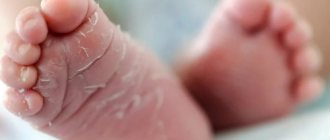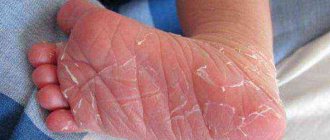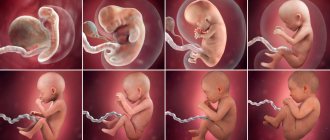Newborn skin, or rather some of its features, can confuse young parents.
An inexperienced mother may be puzzled by several questions about the skin of a newborn:
- Why is a newborn's skin marbled or red?
- Why does a newborn's skin peel?
- Why is a newborn's skin dry?
- what kind of rash appeared on the skin
- What causes a newborn's skin to turn yellow?
and other points relating to the skin of a newborn.
In order to answer all these questions, you need to know the physiology of the skin of a newborn.
How skin changes
The child was born, and we see that he is all some kind of bluish-purple, and then the color of his skin immediately turns red. On the second day after birth, the baby “blushes” the brightest. Doctors call this redness “simple erythema,” and it appears because the skin is adapting to a new environment. Then the baby’s skin turns pale and by the end of the first week of life it becomes the usual pale pink color.
But that is not all. On the third to fifth day of life, the baby's skin may begin to peel, especially on the stomach and chest. What is this? Does the child lack vitamins, is there something wrong with the diet, is the air in the house too dry? No, this is also a transitional state - physiological peeling, and it is also due to the fact that the skin adapts to a new life. The skin peels for about a week, and then everything goes away. You don't need to do anything about it. Of course, you can treat the skin with various softening lotions and creams, but they will not have a significant effect. Very soon the baby's skin will become smooth and soft on its own.
What frightens parents most is the rash on the baby’s skin, which does not often, but sometimes still appear in the first week of life. This is the so-called toxic erythema - spots with grayish-yellow compactions in the center. The rash is most often located on the extensor surfaces of the arms and legs, around the joints, and on the chest. Less commonly, such spots can appear on the entire body (except for the palms, feet and mucous membranes). “Maybe it’s chickenpox, rubella or some other disease?” - Parents are scared. No, this is a peculiar reaction of the skin of a newly born child to its environment, especially to hypothermia, overheating, contact with clothing, and nutrition. New spots may appear within one to three days, but more often, two to three days after they appear, they all disappear without a trace. The child’s well-being is not affected, his body temperature is normal and he does not require any medications. The only thing is that you need to be careful about the bubbles on your skin: for example, gently blot them after bathing. You also need to be careful not to rub the blisters and burst them (otherwise they may become infected).
What other color can a newborn’s skin be and what causes this skin color?
Pale skin occurs with anemia, edema, vasospasm due to cold or fear, with vomiting (in young children, vomiting can be the equivalent of chills when the body temperature rises), with heart defects (aortic valve insufficiency).
With pseudoanemia (the quantitative composition of the blood is not changed) - the mucous membranes remain pink.
With aplastic anemia, the skin color is waxy, with purulent-septic diseases and toxicosis - earthy-gray, with septic endocarditis - the skin is the color of coffee with milk.
Cyanosis (blueness of the skin) appears when oxyhemoglobin drops below 95%. There is total cyanosis, cyanosis around the mouth, nasolabial triangle, tip of the nose, earlobes, acrocyanosis (cyanosis of the hands and feet). In newborns, cyanosis occurs with respiratory distress syndrome, pneumonia, croup, foreign body, congenital heart defects (tetralogy of Fallot).
Limited red-blue spots in the back of the head, on the sacrum, and abdomen, caused by pigment cells located in the deep layers of the skin, disappear independently and without a trace by the age of 5–6 years. Moles remain for life.
Congestion in the portal vein system is indicated by a pronounced venous pattern on the abdomen in the form of a jellyfish head
There will be a separate article on hemangiomas.
What causes marbled skin in a newborn?
The marbled skin pattern in infants is caused by the immaturity of the autonomic nervous system. Uneven filling of blood vessels as a result of a sharp temperature change causes the appearance of a peculiar mesh pattern on the skin. The vessels are visible through the poorly defined granular and stratum corneum layers of the skin and the thin epidermis. These are structural features of the skin of newborns and young children. Marbled skin may be accompanied by cold hands and feet. Usually, as weight increases, the marbling of the skin goes away on its own after about three months of age. But it also happens that this individual feature remains for life.
What to do with marbled skin? Massage, nutrition according to age are indicated, due to which the subcutaneous fat layer will grow, and strict adherence to temperature conditions.
In case of encephalopathy, intracranial trauma, infections affecting the central nervous system, marbled skin can be combined with pathological reflexes of newborns , then consultation and treatment with a neurologist will be required. Especially if marbled skin is combined with an expansion of the venous network on the head, which is caused by increased intracranial pressure, as indicated by a bulging fontanel.
Newborn skin care
In newborns, due to insufficient keratinization of the stratum corneum, the skin is easily vulnerable and easily infected. Therefore, it is necessary to carefully monitor the length of the nails of newborns, who, due to imperfect coordination, can injure themselves.
The resorption (absorption) function of the skin of a newborn is increased due to the thinness of the stratum corneum and the abundance of blood vessels. Therefore, when treating the skin of a newborn, you need to be careful with the choice of ointments, creams and various pastes. So, when peeling the skin, it is better to prefer a domestic baby cream than oil and milk, for example, Johnson's Baby (Johnsons Baby), to which children often develop a skin allergy in the form of a rash of various locations and sizes, and even more serious manifestations of allergies .
For prickly heat, skin irritation, and manifestations of diathesis on the skin, bathe the newborn in herbal decoctions (celandine, string, chamomile). For various skin diseases of a newborn (streptoderma and others), treatment is prescribed only by a doctor.
Physiological jaundice
The changes visible on the skin do not end there. Very often (in 60–70% of children) the skin turns yellow on the second or third day of life, maximum yellowness occurs on the third or fourth day, and by the end of the first week it disappears. physiological jaundice manifests itself - a condition in which the amount of bile pigment, bilirubin, increases in the child. In some children, jaundice will look like a light tan (parents may not notice it), while in others the skin will become a bright yellow color. Very quickly, the bilirubin level returns to normal and the skin color returns to normal. If the jaundice is mild and goes away quickly, then no additional treatment is needed. But if the jaundice does not disappear or the skin color is intensely yellow, you should consult a doctor.
Diagnosis and treatment methods for red skin
If a corresponding problem arises, parents are concerned about the question of when the redness in the newborn will go away. The answer depends entirely on the cause of this condition, which can only be found out after undergoing an examination. If the child was born red, then a visual examination is performed by the doctor for diagnosis.
Note! All elements of the rash have a characteristic appearance. As a rule, tests are not performed for these types of rashes.
Instrumental diagnostics are required if the diagnosis of hemangioma is confirmed. Since such dilated vessels can be on internal organs, an ultrasound examination of the abdominal cavity and retroperitoneal space is performed.
The basics of treating red skin in infants are considered, first of all, to prevent overheating and prevent re-irritation of the skin.
Nurse's diet
In the case of breastfeeding, it is necessary to remove from the mother’s diet all foods that can cause allergies: these are, first of all, citrus fruits, berries, chocolate, honey. It is recommended to establish a balanced diet. You should eat porridge, lean meat, vegetables, and tea with milk.
Treatment with brilliant green
If the skin color of a newborn baby becomes red and rashes appear, doctors often prescribe treating these areas with brilliant green. It is an excellent antiseptic.
Treatment of red spots on the skin of a baby with green paint
Antiallergic drugs
Unlike adults, childhood skin diseases manifest themselves a little differently. Therefore, it is important to be extremely careful not to miss swelling, blisters and changes in the usual allergic spots on the skin.
If the baby has a red face, and the cause of this condition is an allergy, then in this case one of the following drugs is prescribed:
- D-panthenol;
- Bepanten;
- Fenistil;
- Suprastin;
- Claritin.
Weight loss
Do you think the baby will be born immediately well-fed, with folds and cute roundness? No, immediately after birth this is still a long way off. In the first days of life, an already not very well-fed newborn will lose even more weight. This weight loss is a natural process, the so-called physiological weight loss . Weight decreases because immediately after birth the baby loses some of its water through the skin, its umbilical cord dries out, meconium (the first feces) and urine are released, and also because the baby still eats a small amount of milk. Maximum weight loss usually occurs by the third to fifth day and is normally no more than 6–8% of birth weight. At this time, mother and baby are usually discharged from the hospital, but there is no need to worry. By the seventh to tenth day of life, a healthy baby will restore its previous parameters.
What to do if your skin is red
Prevention of the appearance of reddish inflammatory skin in certain areas, for example, in the diaper area, is to properly care for the child. The skin of a newborn is very delicate and requires daily cleansing and care. If, nevertheless, the newborn becomes red, then under no circumstances should you panic. First of all, you need to consult with a specialist who will make an accurate diagnosis and determine the need for treatment.
Often, when redness in newborns goes away, peeling appears in its place, which can be dealt with using creams such as Bepanten or Boro-plus.
Red skin in a newborn immediately after birth is normal and often does not require any action. If a rash appears on the skin against a background of redness, or there are red spots, then you need to consult a doctor.
Note! Any changes that may appear on the skin suddenly, which disrupt the child’s appetite, sleep and general condition, can be dangerous and require immediate help.
Baby red after birth
A newborn's skin is very delicate and easily irritated. To avoid all sorts of problems, it is necessary to properly care for it. There are situations when the baby’s skin becomes red in the first days of life. Most often this is normal and does not require intervention. The most important thing is that the baby feels good and does not have any additional signs of illness.
Stool changes
On the first or second day, all newborns pass their first stool (meconium): it is thick, viscous and dark green in color. Time passes, the baby begins to receive colostrum, and on the third or fourth day of life, transitional stool . Now areas of dark green color alternate with greenish and yellow, and some lumps and mucus are also visible in the stool. This all sounds like some kind of intestinal disorder, but it is not it. The gastrointestinal tract simply switches to a new job, now it is ready to digest food. By the end of the first week of life, most children's stools are yellow and mush-like, and they will continue to be that way.
Warm-cold
A typical fear of all grandmothers is that the child is freezing! Yes, indeed, in newborns the processes of regulating body temperature are still imperfect, so babies easily cool down, but they also overheat just as easily . For example, if a newborn is dressed too warmly or placed next to a radiator, he will quickly overheat, even if this is the normal temperature in the room. At the same time, a child easily loses heat when he is undressed for a long time or lies in wet clothes. Therefore, in the room where there is a newborn, the air temperature should be adequate - 20–22 °C. And if she rises higher, and the child is dressed warmly, then this will also be bad.
Sometimes, very rarely (in 1% of children born), body temperature on the third to fifth day can temporarily rise to 38–39 °C. There are no other symptoms of the disease, the body temperature quickly returns to normal, but the parents manage to get scared. It’s difficult to figure out on your own whether it’s temporary hyperthermia or a disease, so it’s better to call a doctor.
Hormonal crisis
An infrequent occurrence, but it also occurs sometimes. In some children, on the third or fourth day of life, the mammary glands become engorged (both girls and boys). They increase to their maximum by the seventh or eighth day, and liquid discharge may even appear from them. Some girls sometimes have very scanty bleeding from the vagina for a very short time. This is the so-called hormonal crisis - it occurs due to the action of maternal hormones - estrogens (they penetrate through the placenta during childbirth). At the peak of estrogen action, the signs of a hormonal crisis are maximum, then the hormones are eliminated from the body and the symptoms gradually disappear. Therefore, there is no need to apply a cabbage leaf to your chest, make compresses with camphor or anything else: everything will go away on its own.
Usually, all these transitional states are clearly expressed in the first week of life, less often, but it happens that they drag on for up to three to four weeks. Another point is that it is not necessary that the child will exhibit all transitional states, but physiological loss of body weight and transitional stool occurs in almost everyone. And many of the transitional states are completely invisible to parents, but they also exist; they can only be identified only by laboratory methods.
So we don’t rush to get scared when we notice that the child’s skin suddenly begins to peel off or he turns slightly yellow. We remember that he must adapt to the new life, that in the first time after birth the baby has the right to some changes. Especially if, despite all this, the baby is cheerful, calm and eats well. Well, if you are still somehow worried, ask your pediatrician questions. He will definitely be able to put everything in its place.
About the author: Ekaterina Yurievna Koroleva, pediatrician of the highest category, head of Savelovskaya Children's
Types of erythema
Erythema of newborns is characterized by redness of the baby's skin. It may appear as redness on the newborn's face or rashes on the body. Depending on what causes erythema, it comes in two types. Physiological erythema occurs as a reaction of the child’s body to a new environment for him. This is the process of adapting the baby's skin to the outside world.
As you know, many organ systems of a newborn baby do not yet function properly. In particular, this applies, for example, to the thermoregulation system. A child’s skin cannot react to external changes the way the skin of an adult does, which leads to the appearance of various kinds of changes on the skin. As soon as the baby adapts to new living conditions, such manifestations will stop.
There is another type of erythema - toxic. Often it occurs as a continuation of physiological erythema, as an allergic reaction to breast milk.










